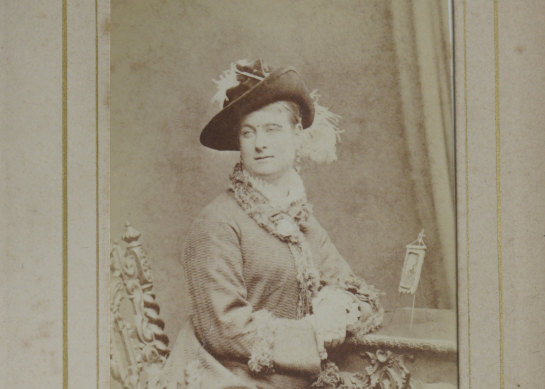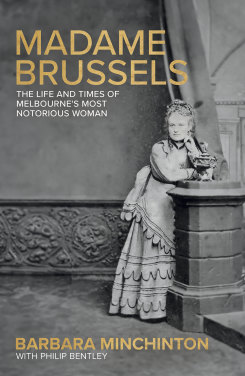HISTORY
Madame Brussels: The Life And Times of Melbourne’s Most Notorious Woman
Barbara Minchinton with Philip Bentley
La Trobe University Press, $36.99
There were several bold and canny businesswomen – “flash madams” as they were known – who during the late 19th century operated brothels on the east side of Melbourne’s CBD. Only one of these women, however, subsequently had a laneway named after her. The legendary Madame Brussels echoes today also in the name of a rooftop cocktail bar. It is a tribute to a woman entrepreneur who offered her clients entertainments that went beyond the units of time booked with the sex workers she employed.

A detail from the visiting card of Caroline Hodgson, aka Madame Brussels.Credit: Deakin University
It is a measure of the skill and tenacity of Barbara Minchinton (working with Philip Bentley) that we know as much about Madame Brussels as we do thanks to this diligently researched and crisply written biography. The sex industry cannot be an easy historical subject to investigate. The people involved preferred to keep their activities concealed, and in any case people in the intensely moralistic era of Queen Victoria did not talk frankly about sex in public.
In colonial Melbourne, brothels were not legal though they were tolerated, at least until the 1890s, when the political climate changed and the industry eventually was outlawed. Victoria introduced a licence system for brothels in 1994 and sex work in the state was decriminalised in 2022.
With her previous book, The Women of Little Lon, Minchinton produced a ground-breaking account of the sex industry in early Melbourne. Her work breaks ground not only in the focus on a hitherto neglected aspect of the city’s history, but also in the sense that information about Melbourne’s original brothels has been gleaned from recent archaeological work on building foundations.

Barbara Minchinton again examines Melbourne’s early sex industry.
At the height of her business success, Madame Brussels owned several buildings situated mainly at the top of Lonsdale Street. Acquiring multiple properties was (and has continued to be) a very Melbourne method of gaining wealth.
Madame Brussels was born Caroline Lohmar in what was then Prussia. She married an Englishman named Studholme Hodgson, the minor scion of a well-to-do English family that produced a number of colonial officials. For his part, Hodgson became a policeman in rural Victoria, and seems to have lived apart from his wife for most of their marriage. Minchinton speculates that he was gay, and that his wife accepted this. She seems to have had genuine affection for him, naming her residence after him and publishing poems in his honour in the years after his death.
At some point in her life Caroline herself may have been a sex worker, though apparently not in Melbourne. Minchinton writes: “Her long-term financial success seems to have come mainly from her ability to choose the right location for her houses, to establish the right environs and ambience, and to offer the best forms of entertainment – that is, to manage the market.”
The optimal location for Madame Brussels’ premises proved to be close to Spring Street and the centre of power and influence in the city. Police attempts to shut down her brothels were stymied by magistrates who may have been clients. But there were restrictions on her ability to conduct her type of business, and she could only flourish by being careful.
The name Madame Brussels contained words that were cleverly chosen. “The combination would have promised the elite version of the trade, simply because in Melbourne that is what being European meant,” Minchinton writes. The clients “could expect culture, sophistication, a salon-like atmosphere, perhaps, or a mastery of the arts of arousal, and the mention of Brussels in particular implied regularly checked, disease-free women”.
This book addresses two of the more persistent myths from this supposedly decadent era: that there was a tunnel connecting Parliament House with a nearby brothel, and the other that the silver-gilt parliamentary mace that went missing in 1891 was taken to a brothel for the amusement of revellers there.
Minchinton has not found evidence to support the veracity of either story, reporting that modern seismic surveys have simply failed to detect the rumoured tunnel. After all, this was the era when “Smellbourne” – as the city was nicknamed – was only just beginning to construct a sewerage system.
Like so much else to do with the sex industry, where Madame Brussels is concerned, fantasy and reality are far from being the same thing.
The Booklist is a weekly newsletter for book lovers from books editor Jason Steger. Get it delivered every Friday.